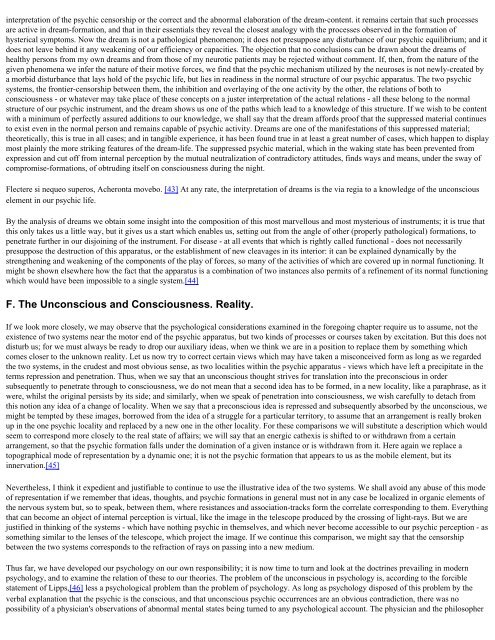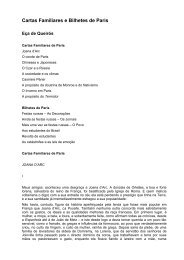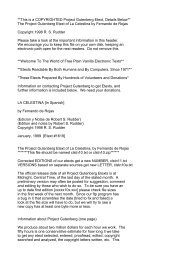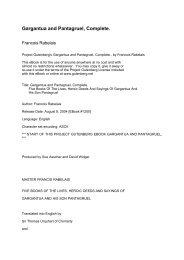The Interpretation of Dreams Sigmund Freud (1900)
The Interpretation of Dreams Sigmund Freud (1900)
The Interpretation of Dreams Sigmund Freud (1900)
Create successful ePaper yourself
Turn your PDF publications into a flip-book with our unique Google optimized e-Paper software.
interpretation <strong>of</strong> the psychic censorship or the correct and the abnormal elaboration <strong>of</strong> the dream-content. it remains certain that such processes<br />
are active in dream-formation, and that in their essentials they reveal the closest analogy with the processes observed in the formation <strong>of</strong><br />
hysterical symptoms. Now the dream is not a pathological phenomenon; it does not presuppose any disturbance <strong>of</strong> our psychic equilibrium; and it<br />
does not leave behind it any weakening <strong>of</strong> our efficiency or capacities. <strong>The</strong> objection that no conclusions can be drawn about the dreams <strong>of</strong><br />
healthy persons from my own dreams and from those <strong>of</strong> my neurotic patients may be rejected without comment. If, then, from the nature <strong>of</strong> the<br />
given phenomena we infer the nature <strong>of</strong> their motive forces, we find that the psychic mechanism utilized by the neuroses is not newly-created by<br />
a morbid disturbance that lays hold <strong>of</strong> the psychic life, but lies in readiness in the normal structure <strong>of</strong> our psychic apparatus. <strong>The</strong> two psychic<br />
systems, the frontier-censorship between them, the inhibition and overlaying <strong>of</strong> the one activity by the other, the relations <strong>of</strong> both to<br />
consciousness - or whatever may take place <strong>of</strong> these concepts on a juster interpretation <strong>of</strong> the actual relations - all these belong to the normal<br />
structure <strong>of</strong> our psychic instrument, and the dream shows us one <strong>of</strong> the paths which lead to a knowledge <strong>of</strong> this structure. If we wish to be content<br />
with a minimum <strong>of</strong> perfectly assured additions to our knowledge, we shall say that the dream affords pro<strong>of</strong> that the suppressed material continues<br />
to exist even in the normal person and remains capable <strong>of</strong> psychic activity. <strong>Dreams</strong> are one <strong>of</strong> the manifestations <strong>of</strong> this suppressed material;<br />
theoretically, this is true in all cases; and in tangible experience, it has been found true in at least a great number <strong>of</strong> cases, which happen to display<br />
most plainly the more striking features <strong>of</strong> the dream-life. <strong>The</strong> suppressed psychic material, which in the waking state has been prevented from<br />
expression and cut <strong>of</strong>f from internal perception by the mutual neutralization <strong>of</strong> contradictory attitudes, finds ways and means, under the sway <strong>of</strong><br />
compromise-formations, <strong>of</strong> obtruding itself on consciousness during the night.<br />
Flectere si nequeo superos, Acheronta movebo. [43] At any rate, the interpretation <strong>of</strong> dreams is the via regia to a knowledge <strong>of</strong> the unconscious<br />
element in our psychic life.<br />
By the analysis <strong>of</strong> dreams we obtain some insight into the composition <strong>of</strong> this most marvellous and most mysterious <strong>of</strong> instruments; it is true that<br />
this only takes us a little way, but it gives us a start which enables us, setting out from the angle <strong>of</strong> other (properly pathological) formations, to<br />
penetrate further in our disjoining <strong>of</strong> the instrument. For disease - at all events that which is rightly called functional - does not necessarily<br />
presuppose the destruction <strong>of</strong> this apparatus, or the establishment <strong>of</strong> new cleavages in its interior: it can be explained dynamically by the<br />
strengthening and weakening <strong>of</strong> the components <strong>of</strong> the play <strong>of</strong> forces, so many <strong>of</strong> the activities <strong>of</strong> which are covered up in normal functioning. It<br />
might be shown elsewhere how the fact that the apparatus is a combination <strong>of</strong> two instances also permits <strong>of</strong> a refinement <strong>of</strong> its normal functioning<br />
which would have been impossible to a single system.[44]<br />
F. <strong>The</strong> Unconscious and Consciousness. Reality.<br />
If we look more closely, we may observe that the psychological considerations examined in the foregoing chapter require us to assume, not the<br />
existence <strong>of</strong> two systems near the motor end <strong>of</strong> the psychic apparatus, but two kinds <strong>of</strong> processes or courses taken by excitation. But this does not<br />
disturb us; for we must always be ready to drop our auxiliary ideas, when we think we are in a position to replace them by something which<br />
comes closer to the unknown reality. Let us now try to correct certain views which may have taken a misconceived form as long as we regarded<br />
the two systems, in the crudest and most obvious sense, as two localities within the psychic apparatus - views which have left a precipitate in the<br />
terms repression and penetration. Thus, when we say that an unconscious thought strives for translation into the preconscious in order<br />
subsequently to penetrate through to consciousness, we do not mean that a second idea has to be formed, in a new locality, like a paraphrase, as it<br />
were, whilst the original persists by its side; and similarly, when we speak <strong>of</strong> penetration into consciousness, we wish carefully to detach from<br />
this notion any idea <strong>of</strong> a change <strong>of</strong> locality. When we say that a preconscious idea is repressed and subsequently absorbed by the unconscious, we<br />
might be tempted by these images, borrowed from the idea <strong>of</strong> a struggle for a particular territory, to assume that an arrangement is really broken<br />
up in the one psychic locality and replaced by a new one in the other locality. For these comparisons we will substitute a description which would<br />
seem to correspond more closely to the real state <strong>of</strong> affairs; we will say that an energic cathexis is shifted to or withdrawn from a certain<br />
arrangement, so that the psychic formation falls under the domination <strong>of</strong> a given instance or is withdrawn from it. Here again we replace a<br />
topographical mode <strong>of</strong> representation by a dynamic one; it is not the psychic formation that appears to us as the mobile element, but its<br />
innervation.[45]<br />
Nevertheless, I think it expedient and justifiable to continue to use the illustrative idea <strong>of</strong> the two systems. We shall avoid any abuse <strong>of</strong> this mode<br />
<strong>of</strong> representation if we remember that ideas, thoughts, and psychic formations in general must not in any case be localized in organic elements <strong>of</strong><br />
the nervous system but, so to speak, between them, where resistances and association-tracks form the correlate corresponding to them. Everything<br />
that can become an object <strong>of</strong> internal perception is virtual, like the image in the telescope produced by the crossing <strong>of</strong> light-rays. But we are<br />
justified in thinking <strong>of</strong> the systems - which have nothing psychic in themselves, and which never become accessible to our psychic perception - as<br />
something similar to the lenses <strong>of</strong> the telescope, which project the image. If we continue this comparison, we might say that the censorship<br />
between the two systems corresponds to the refraction <strong>of</strong> rays on passing into a new medium.<br />
Thus far, we have developed our psychology on our own responsibility; it is now time to turn and look at the doctrines prevailing in modern<br />
psychology, and to examine the relation <strong>of</strong> these to our theories. <strong>The</strong> problem <strong>of</strong> the unconscious in psychology is, according to the forcible<br />
statement <strong>of</strong> Lipps,[46] less a psychological problem than the problem <strong>of</strong> psychology. As long as psychology disposed <strong>of</strong> this problem by the<br />
verbal explanation that the psychic is the conscious, and that unconscious psychic occurrences are an obvious contradiction, there was no<br />
possibility <strong>of</strong> a physician's observations <strong>of</strong> abnormal mental states being turned to any psychological account. <strong>The</strong> physician and the philosopher









